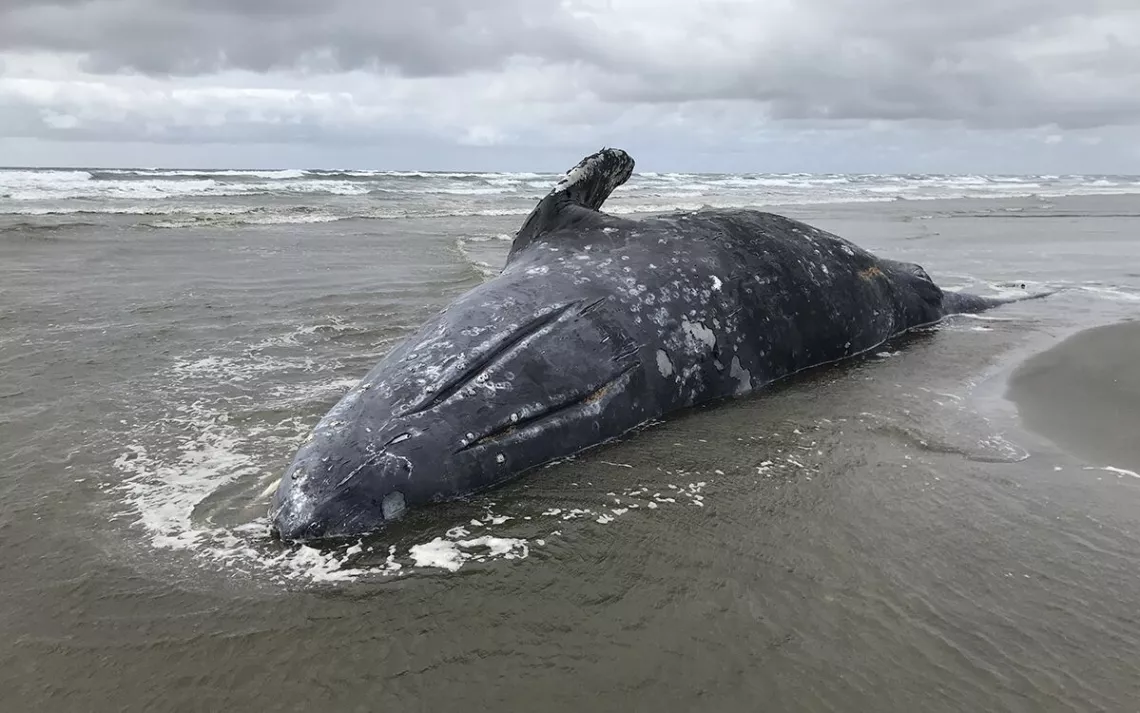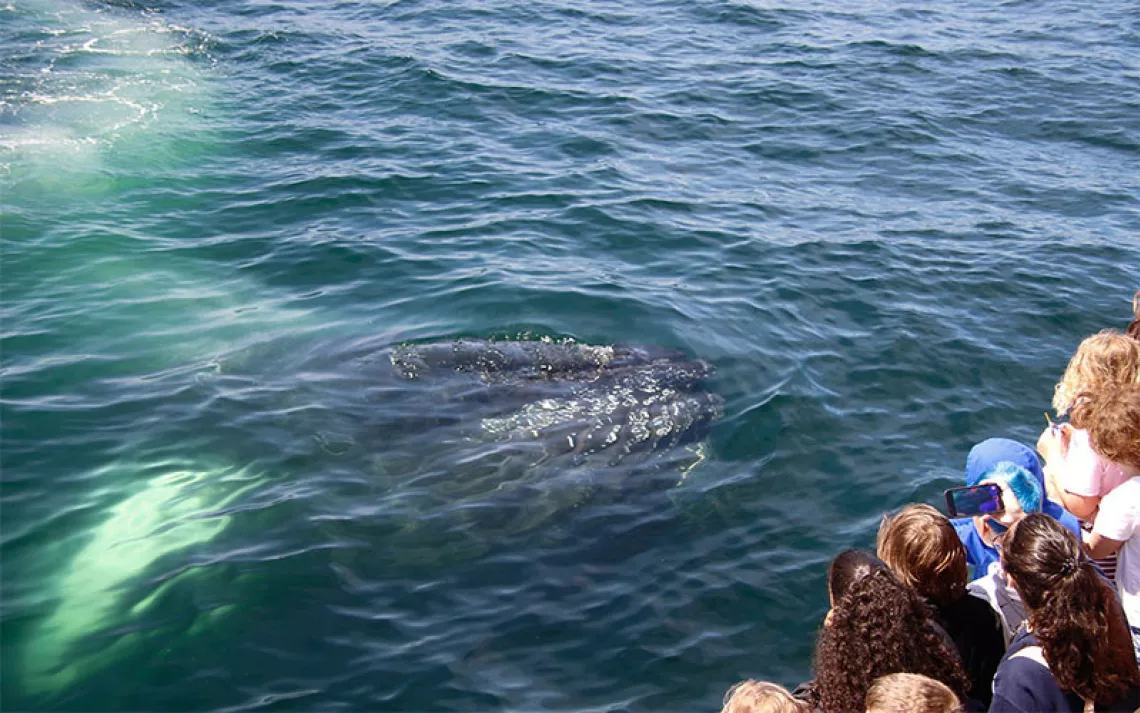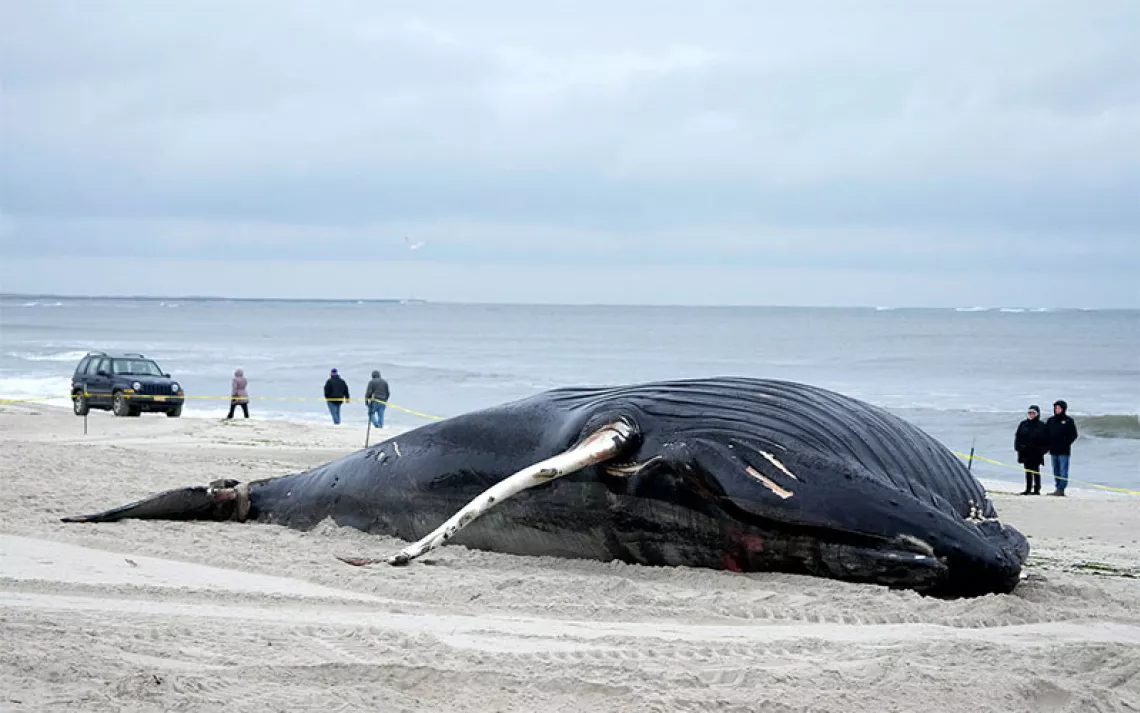What's Killing the Whales?
Gray whales are washing up on West Coast beaches. Most of them starved to death.

A stranded gray whale at Leadbetter Point State Park | Courtesy of NOAA
The vultures circling overhead signaled that something was amiss on Limantour Beach at Northern California’s Point Reyes National Seashore. First we saw a hunk of baleen the size of an ice chest. Farther up the beach, the carrion eaters scattered as we came upon the carcass of a small, much-decayed gray whale. There wasn’t much left to eat anyway—the whale had been there for nearly a week, and a necropsy by a team from the Marine Mammal Center had determined that it had died of malnutrition.
“We’re always looking for anything to give an indication of why the animal stranded,” says Shawn Johnson, the center’s director of veterinary medicine. “Evidence of entanglement, severe trauma from getting hit by a ship, degree of emaciation. There’s a certain shape a nice fat whale has, but sometimes in an emaciated whale the head appears bigger—they call it a peanut-head shape. The Limantour whale died at sea, and then a ship hit it, causing large wounds.”
The dead whale my vacationing family and I stumbled upon in early May was one of 70 found along the West Coast thus far this year—37 in California, 25 in Washington, three in Oregon, and five in Alaska, the most since 2000. (Another whale washed up dead on the same beach a few weeks later.) According to John Calambokidis, a research biologist at the Cascadia Research Collective in Olympia, Washington, the stranded whales may represent as little as 10 percent of those that have died as they migrated up from their wintering grounds in Mexico to Arctic waters. “Most whales—especially emaciated whales—tend to sink when dead,” he says.
While the northward migration is winding down in California, stressed whales are still making their way up the Pacific coast. The last time a similar die-off occurred, says Calambokidis, was in the 1999–2000 season, and then only half of the total deaths had been recorded by this point in the year.
The large number of dead whales led the National Oceanic and Atmospheric Administration (NOAA) to declare an “unusual mortality event,” a designation that triggers a wide-ranging investigation to determine—if possible—the cause. No such determination could be made in the 1999–2000 event, says Sue Moore, a biological oceanographer at the University of Washington. “It was very difficult to get to the whales in a timely fashion,” she says. “We couldn’t always get the samples one would need.” Fewer than 10 whales were necropsied then, while this year—thanks in part to improved networking of researchers and to the fact that many strandings have taken place in easily accessible places like the San Francisco Bay Area—samples have been obtained from more than 20.
So what’s killing the whales? One possible culprit is ship strikes, although voluntary speed restrictions by large vessels moving through marine mammal protected areas have reduced the number from earlier years. “It’s still too many,” says Johnson. “The more we can find ways to reduce the number of whales struck is good for everybody.”
Another possibility is that whale numbers have simply exceeded their carrying capacity. NOAA estimates the number of eastern North Pacific gray whales at 27,000, the highest since population surveys started in 1967. It’s possible, says Dave Weller, a research wildlife biologist with NOAA’s Southwest Fisheries Science Center in La Jolla, California, that that’s as many as the environment is able to sustain. But carrying capacity, he cautions, “is not a hard ceiling but a shifting threshold. In some years the environment is capable of supporting more whales than in other years.”
A rapidly warming Arctic is a likely candidate for decreasing the number of whales the Pacific environment can support. This year’s malnourished stranded whales, says Weller, “are possibly related to poor feeding or feeding conditions during the 2018 summer/fall season.” Gray whales migrate south in November or December, so by May and June of the next year they have reached what he calls “peak nutritional stress.”
One mystery is that in prior years, feeding stress in whales has been linked to late retreat of sea ice, but in the abnormally warm recent years the ice is retreating earlier, not later. “That relationship has broken down in the past few years,” says Weller. “Something has changed, which we’re trying to track.”
The results of the NOAA study, however, may not be available for six months to a year or more. Meanwhile, Arctic waters continue to be abnormally warm, with sea ice extent at the second-lowest point in 40 years of satellite records.
 The Magazine of The Sierra Club
The Magazine of The Sierra Club



